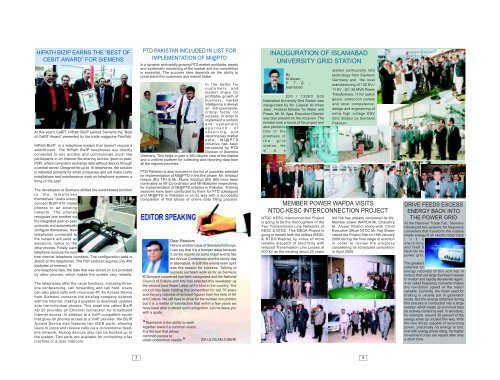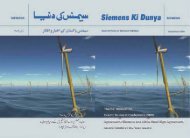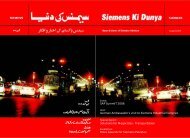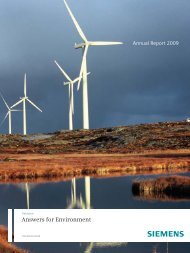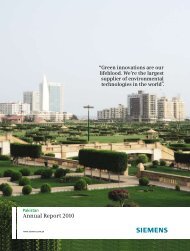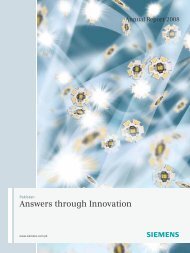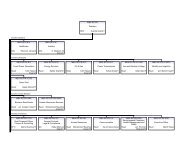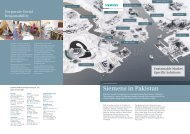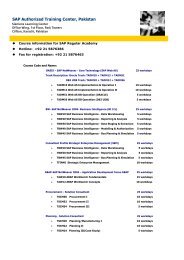Kema Test of Power Transformer Family Day In ... - Siemens Pakistan
Kema Test of Power Transformer Family Day In ... - Siemens Pakistan
Kema Test of Power Transformer Family Day In ... - Siemens Pakistan
Create successful ePaper yourself
Turn your PDF publications into a flip-book with our unique Google optimized e-Paper software.
HIPATH BIZIP EARNS THE “BEST OF<br />
CEBIT AWARD” FOR SIEMENS<br />
At this year's CeBIT, HiPath BizIP earned <strong>Siemens</strong> the “Best<br />
<strong>of</strong> CeBIT Award” presented by the trade magazine TeleTalk.<br />
HiPath BizIP is a telephone system that doesn't require a<br />
switchboard. The HiPath BizIP telephones are directly<br />
connected to one another and communicate much like<br />
participants in an <strong>In</strong>ternet file-sharing service (peer-to-peer,<br />
P2P), where computers exchange data without detours through<br />
a central server. Designed for up to 16 telephones, the solution<br />
is intended primarily for small companies and will make costly<br />
installations and maintenance work on telephone systems a<br />
thing <strong>of</strong> the past.<br />
The developers at <strong>Siemens</strong> shifted the switchboard function<br />
to the telephones<br />
themselves. Users simply<br />
connect BizIP-410 model<br />
phones to an existing<br />
network. The phones<br />
recognize one another via<br />
the integrated peer-to-peer<br />
protocols and automatically<br />
configure themselves. New<br />
telephones connected to<br />
the network will send an<br />
electronic notice to the<br />
other phones. Finally, each<br />
telephone receives the next<br />
free internal telephone numbers. The configuration data is<br />
stored on the telephones. The P2P protocol requires only 400<br />
kilobytes <strong>of</strong> memory. If<br />
one telephone fails, the data that was stored on it is provided<br />
by other phones, which makes the system very reliable.<br />
The telephones <strong>of</strong>fer the usual functions, including threeline<br />
conferencing, call forwarding and call hold. Users<br />
can also place calls with voice-over-IP. An Access Device<br />
from <strong>Siemens</strong> connects the existing company network<br />
with the <strong>In</strong>ternet, making it possible to download updates<br />
onto the individual phones. This small box called BizIP<br />
AD 20 provides an Ethernet connection for broadband<br />
<strong>In</strong>ternet access. <strong>In</strong> addition to a VoIP-compatible router<br />
that gives all phones access to a VoIP provider, the BizIP<br />
Access Device also features two ISDN ports, allowing<br />
users to place and receive calls via a conventional fixedline<br />
network. Analog devices also can be hooked up to<br />
the system: Two ports are available for connecting a fax<br />
machine or a door intercom.<br />
PTD PAKISTAN INCLUDED IN LIST FOR<br />
IMPLEMENTATION OF MI@PTD<br />
<strong>In</strong> a dynamic and rapidly growing PTD market worldwide, steady<br />
and systematic monitoring <strong>of</strong> the market and the competition<br />
is essential. The success here depends on the ability to<br />
understand the customers and market better.<br />
<strong>In</strong> the battle for<br />
customers and<br />
market share for<br />
pr<strong>of</strong>itable growth <strong>of</strong><br />
business, market<br />
intelligence is always<br />
an indispensable,<br />
critical factor for<br />
success. <strong>In</strong> order to<br />
implement a uniform<br />
and systematic<br />
approach <strong>of</strong><br />
observing and<br />
reporting key market<br />
data, MI@PTD<br />
initiative has been<br />
introduced by PTD<br />
Division <strong>of</strong> <strong>Siemens</strong><br />
Germany. This helps to gain a 360-degree view <strong>of</strong> the market<br />
and a uniform platform for collecting and reporting data from<br />
all the regions/countries.<br />
PTD <strong>Pakistan</strong> is also included in the list <strong>of</strong> countries selected<br />
for implementation <strong>of</strong> MI@PTD in the first phase. Mr. Ishtiaqul<br />
Haque (BU TR) & Mr. Munis Siddiqui (BU SB) have been<br />
nominated as MI Co-ordinator and MI-Multiplier respectively,<br />
for implementation <strong>of</strong> MI@PTD initiative in <strong>Pakistan</strong>. Training<br />
sessions have been conducted by them for PTD colleagues<br />
and MI@PTD in <strong>Pakistan</strong> is on its way with a successful<br />
completion <strong>of</strong> first phase <strong>of</strong> online data filling process.<br />
Dear Readers<br />
Here is another issue <strong>of</strong> <strong>Siemens</strong> Ki Dunya.<br />
I can say that it is a bumper issue because<br />
it carries reports on some major events like<br />
the Annual Conference and the family day<br />
in Islamabad. <strong>In</strong> both the events team spirit<br />
was the reason for success. Talking <strong>of</strong><br />
success our team work as far as <strong>Siemens</strong><br />
Ki Dunya is concerned has been recognized and the National<br />
Council <strong>of</strong> Culture and Arts has selected this newsletter as<br />
the second best News Letter <strong>of</strong> it’s kind in the country. The<br />
council has been holding this competition for last 35 years<br />
and the jury consists <strong>of</strong> eminent figures from the field <strong>of</strong> Art<br />
and Culture. We still have to strive for the number one position<br />
but it is a matter <strong>of</strong> satisfaction that within a few years we<br />
have been able to attract such recognition. Let me leave you<br />
with a quote<br />
“ Teamwork is the ability to work<br />
together toward a common vision.<br />
It is the fuel that allows<br />
common people to<br />
attain uncommon results. “<br />
ZIA UL ISLAM ZUBERI<br />
INAUGURATION OF ISLAMABAD<br />
UNIVERSITY GRID STATION<br />
By<br />
M.Akram<br />
P T D -<br />
Islamabad<br />
220 / 132KV GIS<br />
Islamabad University Grid Station was<br />
inaugurated by Mr. Liaquat Ali Khan<br />
Jatoi , Federal Minister for Water and<br />
<strong>Power</strong>. Mr. M. Ilyas, Executive Director<br />
was also present on the occasion. The<br />
minister took a round <strong>of</strong> the project and<br />
also planted a<br />
tree in the<br />
premises <strong>of</strong><br />
the grid<br />
station. He<br />
w a s<br />
MEMBER POWER WAPDA VISITS<br />
NTDC-KESC INTERCONNECTION PROJECT<br />
NTDC KESC <strong>In</strong>terconnection Project<br />
is going to be the thoroughfare <strong>of</strong> the<br />
Two Transmission Line Networks <strong>of</strong><br />
KESC & NTDC. This MEGA Project is<br />
going to benefit both the utilities (KESC<br />
& NTDC/Wapda) by virtue <strong>of</strong> more<br />
reliable dispatch <strong>of</strong> electricity with<br />
reduced Transmission Line Losses at<br />
500 kV as the existing about 20 years<br />
station particularly GIS<br />
technology from <strong>Siemens</strong><br />
Germany and the local<br />
manufacturing <strong>of</strong> 132 KV /<br />
11 KV , 20 / 26 MVA <strong>Power</strong><br />
<strong>Transformer</strong>s, 11 KV switch<br />
gears, protection panels<br />
and local competence,<br />
design and engineering <strong>of</strong><br />
extra high voltage ESV<br />
Grid Station by <strong>Siemens</strong><br />
<strong>Pakistan</strong><br />
old link has already completed its life.<br />
Member power WAPDA Mr. Chaudhry<br />
M. Anwer Khalid along-with Chief<br />
Executive Officer NTDC Mr. Haji Shabir<br />
visited the Project Site on 19th January<br />
2006 during the final stage <strong>of</strong> erection<br />
in order to review the progress<br />
considering its scheduled completion<br />
in April 2006.<br />
3 4<br />
DRIVE FEEDS EXCESS<br />
ENERGY BACK INTO<br />
THE POWER GRID<br />
At the Hanover Trade Fair, <strong>Siemens</strong><br />
introduced two systems for frequency<br />
converters that transform the surplus<br />
kinetic energy <strong>of</strong> an electric motor back<br />
i n t o<br />
electricity<br />
and feed it<br />
back into the<br />
power grid.<br />
The greatest<br />
potential for<br />
energy recovery <strong>of</strong> this sort lies in<br />
motors that set large flywheel masses<br />
in motion and rapidly decelerate again.<br />
A so called frequency converter makes<br />
the revolution speed <strong>of</strong> the motor<br />
variable. Currently, the motor used for<br />
braking is usually put in generator<br />
mode. But the energy obtained during<br />
this process is conducted into a large<br />
resistor, which heats up and must then<br />
be actively cooled as well. <strong>In</strong> elevators,<br />
for example, around 30 percent <strong>of</strong> the<br />
energy ends up unused this way. With<br />
the new drives capable <strong>of</strong> recovering<br />
power, practically no energy is lost.<br />
And with energy prices rising, the higher<br />
investment costs are repaid after only<br />
a short time.


